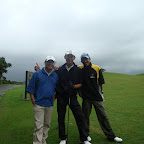 5. BACKSWING
5. BACKSWING
To the untrained eye, this position doesn’t look all that bad. In fact, it wouldn’t be surprising if some amateurs aspire to have this position at the top of their backswing. My weight has transitioned, my legs are flexed, my left arm is fairly straight, and I’m in balance. What’s wrong with that? The truth behind this position is, my body has done no more than simply shift to the side, my hips have barely turned, and my shoulders have turned ever so slightly. I may, on occasion, be able to hit a few balls well from this position, but any attempt to become a consistent ballstriker are slim at best. You may not be able to tell, but if I were to hold this position any longer, I’d start to fall forward. Check your own position at the top and see if you look like I do here. If so, the solution to your problem is one page away.
 My improper position is even more deceiving from behind. It looks as though I’m on track, considering I have indeed shifted my weight, and my hands are high above my body. But don’t be fooled. A powerful swing has nothing to do with high hands; rather it comes from making an effective turn.
My improper position is even more deceiving from behind. It looks as though I’m on track, considering I have indeed shifted my weight, and my hands are high above my body. But don’t be fooled. A powerful swing has nothing to do with high hands; rather it comes from making an effective turn.
 Notice the drastic difference. In this photo, I’ve done it right. Notice how my core hasn’t drifted off the ball, my hips have rotated considerably, and my shoulders are fully rotated. That’s the secret! If you rotate effectively, your body weight will shift on its own. In my case, I like to flare my knees out to allow for a greater lower rotation, which in turn, makes it easier for my upper body to rotate as well. As for a mental note, I like to think of keeping my belt line as level as I can.
Notice the drastic difference. In this photo, I’ve done it right. Notice how my core hasn’t drifted off the ball, my hips have rotated considerably, and my shoulders are fully rotated. That’s the secret! If you rotate effectively, your body weight will shift on its own. In my case, I like to flare my knees out to allow for a greater lower rotation, which in turn, makes it easier for my upper body to rotate as well. As for a mental note, I like to think of keeping my belt line as level as I can.
 Notice my head position, as well. On the previous page, my head was closer to my left side. Here, it’s over my right leg, demonstrating more stored energy behind the ball. Try to keep your spine tilted away from the target at the top of your swing, as opposed to toward the target, as well.
Notice my head position, as well. On the previous page, my head was closer to my left side. Here, it’s over my right leg, demonstrating more stored energy behind the ball. Try to keep your spine tilted away from the target at the top of your swing, as opposed to toward the target, as well.
Looking at the photo, you can probably see how my right side is stored with a lot of energy. The myth has long been that you need to stack your right side at the top of your swing. What you should do is rotate around your core and let your weight shift on its own. Don’t force a weight shift. It will happen automatically.
 6. LOOK AT THE FRONT OF THE BALL
6. LOOK AT THE FRONT OF THE BALL
Look in front of the ball. I hit a lot of golf balls, both in practice and competition. Admittedly, it’s easy for me to fall into bad habits without actually noticing them until after the damage is done. Usually, those habits are basic fundamentals that my coach and I can iron out in a couple practice sessions, but if we don’t, they can grow into bigger swing problems. In the case of how I set up over the ball, where I fixate my eyes makes a big difference in how I?swing through the ball. If I focus on the back of the ball, I’m more likely to hang back and hit the ball more on an ascending plane. If I look to either side of the ball, I’ll likely hit either a draw or fade. But if I look in front of the ball (the side toward the target), I’m more inclined to make a level and solid stroke into the golf ball. I also find that I decelerate less, and I make a better extension because I swing more through to the finish.
Try this technique the next time you hit balls or play. Focus ahead of the ball, and see if it impacts your swing as much as it does mine.
One of my favorite drills involves a 2x4. Although many of my peers swear by a handful of training aids, I happen to favor a simpler approach toward helping me become a better player. In this case, a simple 2x4 does the trick. I like to stand on the 2x4 with it positioned in the center of both of my feet. As I make a few swings, the 2x4 not only forces me to swing with more balance and better tempo, but also prevents me from having too little or too much lean into the ball at impact. That kind of practice does wonders for my ballstriking and helps me find the sweet spot much more often.
To try for yourself, grab a 2x4 at your local hardware store and position it as I have under my feet. As you swing, make sure you hit down and through into the ball, and allow your back foot to come off the board as you reach your finish position. Your balance will be tested, as will your rhythm and spine angle, but after a few practice sessions, you’ll start seeing some serious improvements in how solid you hit your shots.
If you do swing off balance, whether it’s due to bad rhythm or bad form, you’ll fall off the 2x4 (as I did in the photo to the left). Stick with it, and in no time, you’ll be glad you invested a couple bucks at the hardware store.





























































































